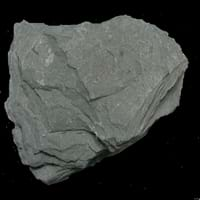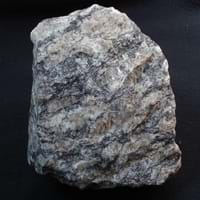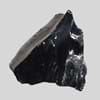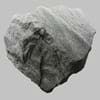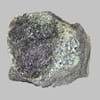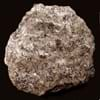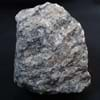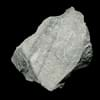Definition
Slate is a fine-grained, foliated, homogeneous metamorphic rock derived from an original shale-type sedimentary rock composed of clay or volcanic ash through low-grade regional metamorphism
Gneiss is a common and widely distributed type of rock formed by high-grade regional metamorphic processes from pre-existing formations that were originally either igneous or sedimentary rocks
Discoverer
Unknown
Unknown
Etymology
From Old French esclate, from esclat (French éclat)
From the Middle High German verb gneist (to spark; so called because the rock glitters)
Class
Metamorphic Rocks
Metamorphic Rocks
Sub-Class
Durable Rock, Medium Hardness Rock
Durable Rock, Hard Rock
Group
Not Applicable
Not Applicable
Other Categories
Fine Grained Rock, Opaque Rock
Coarse Grained Rock, Medium Grained Rock, Opaque Rock
Texture
Foliated
Banded, Foliated, Platy
Color
Black, Brown, Buff, Green, Light to Dark Grey, Purple, Red, Shades of Blue
Black, Brown, Pink, Red, White
Durability
Durable
Durable
Scratch Resistant
Yes
Yes
Interior Uses
Bathrooms, Decorative Aggregates, Entryways, Floor Tiles, Flooring, Homes, Hotels, Interior Decoration, Kitchens, Stair Treads
Countertops, Decorative Aggregates, Flooring, Interior Decoration
Exterior Uses
As Building Stone, As Facing Stone, Garden Decoration, Paving Stone
As Building Stone, As Facing Stone, Garden Decoration, Paving Stone
Other Architectural Uses
Curbing
Curbing
Construction Industry
As Dimension Stone
As Dimension Stone
Medical Industry
Not Yet Used
Not Yet Used
Antiquity Uses
Artifacts, Monuments, Sculpture, Small Figurines
Artifacts
Commercial Uses
Blackboards, Commemorative Tablets, Laboratory bench tops, Standard material for the bed of Billiard table, Standard material for the beds of Pool and Snooker table, Tombstones, Used in aquariums, Writing Slates
Cemetery Markers, Jewelry, Tombstones, Used in aquariums
Types
Not Available
Augen Gneiss, Henderson Gneiss, Lewisian Gneiss, Archean and Proterozoic Gneiss.
Features
Easily splits into thin plates, Surfaces are often shiny, Very fine grained rock
Generally rough to touch, Is one of the oldest rock
Archaeological Significance
Famous Monuments
Data Not Available
Konark Sun Temple in India, Washington Monument, US
Sculpture
Used
Not Yet Used
Famous Sculptures
Data Not Available
Not Applicable
Pictographs
Used
Not Used
Petroglyphs
Used
Not Used
Figurines
Used
Not Yet Used
Formation
Slate is a low grade metamorphic rock that is generally formed by metamorphosis of mudstone or shale, under relatively low pressure and temperature conditions.
Gneiss is a high grade metamorphic rock i.e. it has been subjected to higher temperatures and pressures than schist. It is formed by the metamorphosis of Gneiss forms from volcanic rock, shale or granitie.
Mineral Content
Apatite, Biotite, Chlorite, Feldspar, Graphite, Hematite, Kaolinite, Magnetite, Pyrite, Tourmaline, Zircon
Biotite, Chlorite, Feldspar, Garnet, Graphite, Hornblade, Micas, Muscovite or Illite, Quartz, Quartzite, Silica, Zircon
Compound Content
Aluminium Oxide, CaO, Iron(III) Oxide, Potassium Oxide, MgO, Sodium Oxide, Silicon Dioxide, Titanium Dioxide
Aluminium Oxide, NaCl, CaO, Iron(III) Oxide, FeO, Potassium Oxide, Magnesium Carbonate, MgO, MnO, Phosphorus Pentoxide, Silicon Dioxide, Titanium Dioxide
Types of Metamorphism
Burial Metamorphism, Cataclastic Metamorphism, Regional Metamorphism
Impact Metamorphism
Types of Weathering
Biological Weathering, Chemical Weathering, Mechanical Weathering
Biological Weathering, Mechanical Weathering
Types of Erosion
Coastal Erosion, Glacier Erosion, Water Erosion, Wind Erosion
Chemical Erosion, Coastal Erosion, Sea Erosion
Grain Size
Very fine-grained
Medium to Coarse Grained
Fracture
Splintery
Irregular
Streak
Light to dark brown
White
Porosity
Less Porous
Very Less Porous
Specific Gravity
2.65-2.8
2.5-2.7
Transparency
Opaque
Translucent to Opaque
Density
2.6-2.8 g/cm3
2.6-2.9 g/cm3
Specific Heat Capacity
Not Available
Resistance
Heat Resistant, Impact Resistant, Pressure Resistant, Wear Resistant
Heat Resistant, Pressure Resistant, Scratch Resistant, Wear Resistant
Deposits in Eastern Continents
Asia
China, India, Turkey
China, India, Iran, Iraq, Kazakhstan, Kyrgyzstan, Mongolia, Russia
Africa
Not Yet Found
Cameroon, Ethiopia, Ghana, Kenya, Madagascar, Morocco, Mozambique, Namibia, Nigeria, Tanzania, Togo
Europe
Belgium, France, Germany, Italy, Norway, Portugal, Spain, United Kingdom
Albania, Austria, Bosnia and Herzegovina, Finland, France, Georgia, Germany, Hungary, Italy, Kosovo, Monaco, Norway, Poland, Romania, Serbia, Slovakia, Slovenia, Switzerland, Ukraine, United Kingdom
Others
Arctic
Not Yet Found
Deposits in Western Continents
North America
USA
Canada, Costa Rica, Cuba, Mexico, Panama, USA
South America
Brazil
Argentina, Bolivia, Brazil, Chile, Colombia, Ecuador, Peru, Venezuela
Deposits in Oceania Continent
Australia
Not Yet Found
New South Wales, New Zealand, Queensland, Victoria
All about Slate and Gneiss Properties
Know all about Slate and Gneiss properties here. All properties of rocks are important as they define the type of rock and its application. Slate and Gneiss belong to Metamorphic Rocks.Texture of Slate is Foliated whereas that of Gneiss is Banded, Foliated, Platy. Slate appears Dull and Gneiss appears Foliated. The luster of Slate and Gneiss is dull. Slate is available in black, brown, buff, green, light to dark grey, purple, red, shades of blue colors whereas Gneiss is available in black, brown, pink, red, white colors. The commercial uses of Slate are blackboards, commemorative tablets, laboratory bench tops, standard material for the bed of billiard table, standard material for the beds of pool and snooker table, tombstones, used in aquariums, writing slates and that of Gneiss are cemetery markers, jewelry, tombstones, used in aquariums.
